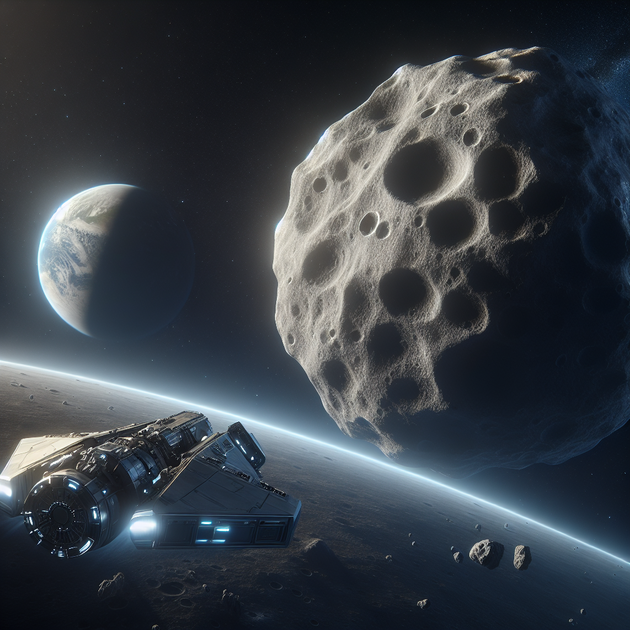Ever thought about what would happen if an asteroid smashed into the Moon? According to a recent NASA proposal, this scenario isn’t just sci-fi—it’s a real possibility. There’s an asteroid cruising through space right now with a 4% chance of striking our lunar neighbor, and if it does, it could scatter harmful debris that might even pose risks to satellites or spacecraft near Earth. That’s why NASA’s talking about a plan straight out of a blockbuster movie: destroying the asteroid before it gets anywhere close.
Why Is This Asteroid Such a Big Deal?
The primary concern behind the NASA asteroid proposal isn’t just about protecting the Moon for future astronauts or lunar bases—it’s also about preventing a cascade of moon debris that could endanger all sorts of space technology. Now, 4% might sound like low odds, but in cosmic terms, that’s enough to warrant action. If this rogue rock slams into the Moon at high speed:
- It could carve out a massive new crater
- The impact might eject thousands (or millions) of tons of lunar material into orbit
- Some debris could get caught in Earth’s gravity and threaten satellites or even crewed missions
- The cost and cleanup would be astronomical—literally!
Space agencies have always kept an eye out for asteroids that threaten Earth—think of programs like Planetary Defense Coordination Office—but targeting one because it threatens the Moon is something new.
How Would NASA Destroy an Asteroid?
If you’re picturing Hollywood-style explosions or Bruce Willis on standby—well, you’re not completely off base! The tools for planetary defense have evolved fast over the past decade. Here’s what NASA might actually do:
- Send an uncrewed spacecraft on a collision course (like they did with DART in 2022)
- Use kinetic impactors—basically turning spacecraft into giant bullets
- Explore using nuclear devices as a last resort (highly controversial but effective)
- Monitor and adjust trajectory using gravity tractors or other spacecraft “nudges”
The key is timing. It takes months or even years to plan such missions because you need to meet the asteroid far enough from its target—whether that’s Earth or our trusty Moon.
The Ripple Effects of Lunar Debris
What happens if nothing is done? Let’s say this asteroid hits and creates clouds of rocky fragments around the Moon. Those fragments don’t just sit still; they spread out over time and can cross paths with satellites in high lunar orbit—orbits some agencies are planning for future lunar gateways. The International Space Station is safe (it orbits much lower), but GPS satellites or lunar landers? They’re suddenly at risk.
A friend who works in aerospace once described orbital debris as “the most boring but terrifying part” of his job. During college internships tracking satellite positions, he’d see how even tiny bits of junk force $100 million satellites to dodge out of harm’s way. Now imagine dealing with fresh shrapnel flying out from the Moon!
What Could Go Wrong With This Plan?
No space mission is risk-free—and blowing up an asteroid isn’t exactly routine business yet. Here are some potential pitfalls:
- If pieces break off instead of total destruction, we could face multiple smaller threats instead of one big one
- The mission timing has to be perfect—a miss means we lose our shot
- International cooperation is needed since lunar debris affects every nation using space
- The public reaction to “blowing things up in space” can be mixed (and politically tricky!)
NASA will have to weigh these risks against doing nothing at all.
An Astronaut’s Perspective
Back when Apollo astronaut Jack Schmitt returned from his trip to the Moon, he described seeing Earthrise as both beautiful and fragile—a reminder that everything in space is more connected than we think. Today’s missions might not have humans on board yet, but protecting our little corner of the solar system has never felt more urgent.
Final Thoughts—Is Destroying Asteroids Our New Normal?
If this NASA proposal moves forward, it’ll mark another leap toward active planetary defense—not just for Earth but for everything we send into space. Whether you’re worried about moon dust hitting your cell signal or just fascinated by humanity flexing its cosmic muscles, this story shows how science fiction ideas are becoming real plans.
What do you think—should we actively stop every potential threat in space? Or does blowing up asteroids sound like tempting fate? Let us know your thoughts!

Leave a Reply